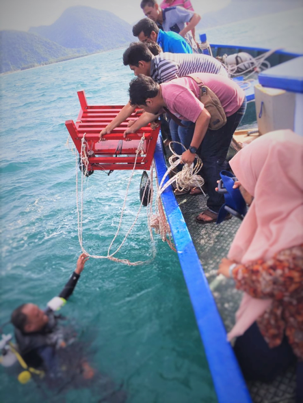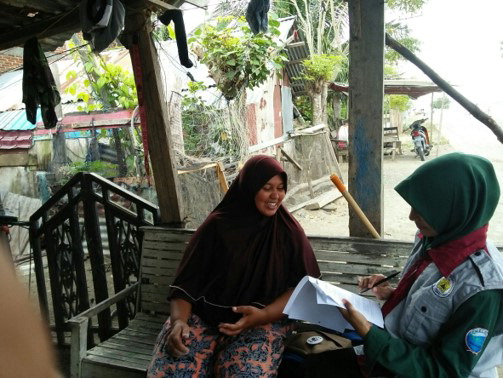Cycle 5 (2015 Deadline)
Incorporating climate change induced sea level rise information into coastal cities’ preparedness toward coastal hazards
PI: Syamsidik (syamsidik@tdmrc.org), Tsunami and Disaster Mitigation Research Center (TDMRC), Syiah Kuala University
U.S. Partner: Louise K. Comfort, University of Pittsburgh
Project Dates: December 2016 - March 2022
Project Overview
Research has not yet identified all the impacts of climate changes on island nations like Indonesia. One of the challenges is the complexity of the available data in Indonesia. This project is aimed at combining two sets of processes—climate change-induced sea level rise and coastal hazards (coastal erosion, tsunami, and coastal flooding)—using three projected periods (30, 50, and 100 years). Climate change-induced sea level rise coupled with coastal hazards is a rarely studied topic in Indonesia. Dr. Syamsidik and his team expect that the project should produce newly developed scenarios for assessing impacts of climate change-induced sea level rise in Indonesia’s coastal cities, combining information on sea level rise (a slow process) and coastal hazards (a relatively fast process). Their work will also incorporate scientifically based policy analysis of urban development planning in order to increase the preparedness of cities in the region. In addition, this research will compare the projected impacts of sea level rise coupled with coastal hazards between two coastal cities representing the northern hemisphere and southern hemisphere of Indonesia. The impact comparisons will highlight variations resulting from geographical differences. This research will also offer examples for incorporating scientific evidence on climate change and coastal hazard impacts with techno-social approaches for disaster mitigation and climate change adaptation.
U.S. partner Dr. Comfort will assist this research team with her expertise in analyzing development planning policies. Her techno-social approach will a valuable resource for the Indonesian team. To gather input and disseminate their findings, Dr. Syamsidik and his colleagues will organize several forums for stakeholders from the national and local levels. Two policy briefings will be made to address the issue of climate change impacts and their incorporation into development planning for coastal cities in Indonesia. This research team will also produce inputs for improving university-level instruction in courses involving climate change and disaster management. Lessons learned from this research process will be used in revising the relevant course curricula at Syiah Kuala University in Banda Aceh and Mataram University in Mataram.
Final Summary of Project Activities
 |  | | The team conducted a series of activities in Banda Aceh including resident surveys and coastal dynamic monitoring (photos courtesy of Dr. Syamsidik) |
Dr. Syamsidik reports that his team’s research results have made positive impacts from both the scientific and policy standpoints. The team members have also gained many opportunities to enhance their capacity in performing spatial analysis and numerical simulations and their ability to communicate and advocate for their research results. This in turn has also contributed to their university’s performance at the national and international levels. Recently, their research center (TDMRC) also received important grants from Ministry of Education, Culture, Research and Technology of Indonesia, which will enable them to purchase advanced research equipment. Their two PEER grants (the other in Cycle 3) allowed the PI and his team to prove their abilities and competence to conduct high-quality tsunami-related research.
At the local level, the researchers expect to maintain long-term collaboration with the municipal governments in Banda Aceh, Mataram, and Ambo, their study sites for the current project. Preparedness of coastal cities towards impacts of climate change induced sea level rise is indeed a challenging issue in the context of Indonesia. During this research, Dr. Syamsidik and his colleagues have proposed ways of increasing the cities' preparedness by providing science-based information that can be integrated into the city's policies. Although they also identified some potential obstacles during the integration, they are confident that these obstacles can be eliminated or minimized through continuous collaboration with the municipal authorities. In addition to these local impacts, the team has also delivered outcomes at the national and international level by conducting a series of activities as part of the South-South and Triangular Cooperation coordinated by Ministry of Foreign Affairs of Indonesia. Two PEER grant supplements provided them with the opportunity to work with the Timor-Leste government as part of this effort.
Following are several other key achievements as of the summer of 2022 to be highlighted from this five-year project: - 21 publications, including 19 papers in international journals and conference proceedings and two book chapters
- Creation of a new mandatory course on Knowledge of Disaster and Environment, which is taken by about 3,500 students per semester at Syiah Kuala University
- Five new research grants totaling $150,000 (four from Indonesian sponsors and one from the government of Japan)
- Promotion of the PI Dr. Syamsidik to full professor based on his research accomplishments
- Awards from the Indonesian National Disaster Agency to two team members for their work as tsunami mitigation and numerical simulation researchers
Although PEER funding has ended, at the time of the final report in July 2022 Dr. Syamsidik had plans for several follow-on activities. In September 2022, he expected to resume working with the Ambon Development and Planning Agency on integrating information on historical tsunamis into the city’s spatial planning efforts. In Banda Aceh, the team planned to continue developing probabilistic tsunami hazard maps and probable loss estimations for building damages due to tsunamis. The activities in Banda Aceh and Ambon are expected to run at least through 2024. At the national level, the team will work closely with units of the Ministry of Finance to formulate models for disaster risk financing and insurance, in which information from their tsunami models and experience developed during the two PEER grants will be very useful. As of the summer of 2022, the PI and his group were already working on another important study funded by the Ministry of Finance of Indonesia on providing strategies for disaster risk financing and insurance in Indonesia. Part of the research involves providing tsunami hazard information and analysis to compose the strategies. This project will also run through 2024. Furthermore, another study on the tsunami topic is under way in Banda Aceh and Ambon with funding from the Japanese program SATREPS. Research completed during the two PEER projects will provide a strong foundation for all of these ongoing efforts.
Policy Documents
“Management of Coastlines of Mataram as Parts of Adaptation and Mitigation of Coastal Hazards and Sea Level Rise" (download PDF)
“Strategies of Tsunami and Coastal Flooding for Banda Aceh Exacerbating by Impacts of Climate Change Induced Sea Level Rise” (download PDF)
Publications and Other Useful Links
Ibrahim, Syamsidik, Azmeri, M. Hasan, and Tursina. 2022. “Investigating characteristics of tsunami hazards for west coast of Aceh Besar district, Indonesia.” E3S Web Conf. 340, 01005. https://doi.org/10.1051/e3sconf/202234001005
Tursina, Syamsidik, S. Kato, and M. Afifuddin. 2022. “Incorporating dynamics of land use and land cover changes into tsunami numerical modelling for future tsunamis in Banda Aceh.” E3S Web Conf. 340, 01014. https://doi.org/10.1051/e3sconf/202234001014
Tursina, Syamsidik, Shigeru Kato, and Mochammad Afifuddin. 2021. Coupling sea-level rise with tsunamis: projected adverse impact of future tsunamis on Banda Aceh City, Indonesia. International Journal of Disaster Risk Reduction 55:102084. https://doi.org/10.1016/j.ijdrr.2021.102084
Syamsidik, A. Nugroho, and M. Fahmi. 2021. The 2004 Indian Ocean Earthquake and Tsunami: Resettlement and Demographic Challenges. In: Pulhin J.M., M. Inoue, and R. Shaw (eds), Climate Change, Disaster Risks, and Human Security. Disaster Risk Reduction (Methods, Approaches and Practices). Springer, Singapore. https://doi.org/10.1007/978-981-15-8852-5_15
Benazir, Syamsidik, and M. Luthfi. 2020. Assessment on damages of harbor complexes due to impacts of the 2018 Palu-Donggala tsunami, Indonesia. In: Trung Viet, N., D. Xiping, and T. Thanh Tung (eds) APAC 2019. Springer, Singapore. https://doi.org/10.1007/978-981-15-0291-0_36
Syamsidik, Benazir, Mumtaz Luthfi, Anawat Suppasri, and Louise K. Comfort. 2020. The 22 December 2018 Mount Anak Krakatau volcanogenic tsunami on Sunda Strait coasts, Indonesia: tsunami and damage characteristics. Natural Hazards and Earth System Sciences 20, 549-565, 1561-8633. https://doi.org/10.5194/nhess-20-549-2020
Syamsidik, T.M. Rasyif, A. Suppasri, M. Fahmi, M. Alala, W. Akmal, T.M. Hafli, and A. Fauzia. 2020. Challenges in increasing community preparedness against tsunami hazards in tsunami-prone small islands around Sumatra, Indonesia. International Journal of Disaster Risk Reduction 47, 101572-101572, 2212-4209. https://www.sciencedirect.com/science/article/abs/pii/S2212420919315481
Rusydy, I., Y. Idris, Mulkal, et al. 2020. Shallow crustal earthquake models, damage, and loss predictions in Banda Aceh, Indonesia. Geoenvironmental Disasters 7, 8. https://doi.org/10.1186/s40677-020-0145-5
Oktari, R.S., Louise K. Comfort, Syamsidik, and Putra Dwitama. 2020. Measuring coastal cities' resilience toward coastal hazards: Instrument development and validation. Progress in Disaster Science 5, 100057, 2590-0617. https://www.sciencedirect.com/science/article/pii/S2590061719300572
Oktari, R.S., Syamsidik, K. Munadi, R. Idroes, and H. Sofyan. 2020. City resilience towards coastal hazards: an integrated bottom-up and top-down assessment. Water 12(10), 2823.
https://doi.org/10.3390/w12102823
Fauzia, A., Syamsidik, and S. Syahreza. 2020. “Spatio-temporal shoreline changes analysis based on Landsat satellite images in Lahewa Beach of North Nias due to tectonics 2005 Spatio-temporal shoreline changes analysis based on Landsat satellite images in Lahewa Beach of North Nias due to tectonics 20.” IOP Conf. Ser.: Mater. Sci. Eng. 933, 012055. https://doi.org/10.1088/1757-899X/933/1/012055
Meilianda, E., B. Pradhan, Syamsidik, L.K. Comfort, D. Alfian, R. Juanda, S. Syahreza, and K. Munadi. 2019. “Assessment of post-tsunami disaster land use/land cover change and potential impact of future sea-level rise to low-lying coastal areas: a case study of Banda Aceh coast of Indonesia,” Int. J. Disaster Risk Reduct. 41, 101292. https://doi.org/10.1016/j.ijdrr.2019.101292
Al’ala, M., and Syamsidik. 2019. “Coastal flooding impacts induced sea level rise on Banda Aceh coastal morphology coastal flooding impacts induced sea level rise on Banda Aceh coastal morphology.” IOP Conf. Ser. Earth Environ. Sci. 273, 012007. https://doi.org/10.1088/1755-1315/273/1/012007
Tursina and Syamsidik. 2019. “Reconstruction of the 2004 tsunami inundation map in Banda Aceh through numerical model and its validation with post-tsunami survey data.” IOP Conf. Ser. Earth Environ. Sci. 273, 012008. https://doi.org/10.1088/1755-1315/273/1/012008
Syamsidik, Tursina, Anawat Suppasri, Musa Al'ala, Mumtaz Luthfi, and Louise K. Comfort. 2019. Assessing the tsunami mitigation effectiveness of a planned Banda Aceh Outer Ring Road (BORR), Indonesia. Natural Hazards and Earth System Sciences 19, 299–312. https://www.nat-hazards-earth-syst-sci-discuss.net/nhess-2018-276/
Syamsidik, Benazir, Muksin Umar, Giordano Margaglio, and Afri Fitrayansyah. 2019. Post-tsunami survey of the 28 September 2018 tsunami near Palu Bay in Central Sulawesi, Indonesia: Impacts and challenges to coastal communities. International Journal of Disaster Risk Reduction 38, 101229. https://www.sciencedirect.com/science/article/pii/S2212420919302882
Syamsidik, M. Fahmi, E. Fatimah, and A. Fitrayansyah. 2018. “Coastal land use changes around the Ulee Lheue Bay of Aceh during the 10-year 2004 Indian Ocean tsunami recovery process,” Int. J. Disaster Risk Reduct. 29, 24–36. https://doi.org/10.1016/j.ijdrr.2017.07.014
Sulistiyono, H., E. Pradjoko, and S. Syamsidik. 2018. “Impact of climate change on coastal wind (case study in Mataram, Lombok, Indonesia).” IAHR-APD 2018, April 2018. https://www.researchgate.net/publication/321162042_Impact_of_Climate_Change_on_Coastal_Wind_Case_Study_in_Mataram_Lombok_Indonesia
Pradjoko, E., H. Sulistiyono, S. Syamsidik, and H. Hartana. 2018. “The prediction of tsunami travel time to Mataram City Indonesia based on North Lombok earthquake as the initial condition.” MATEC Web Conf. 229, 04007. https://doi.org/10.1051/matecconf/2018229
Tursina, Syamsidik, and S. Kato. 2017. “Projections of tsunami inundation area coupled with impacts of sea level rise in Banda Aceh, Indonesia.” AIP Conf. Proc. 1892, 100003. https://doi.org/10.1063/1.5005735
Al’ala, M., Syamsidik, and S. Kato. 2017. “Predicting impact of SLR on coastal flooding in Banda Aceh coastal defences.” AIP Conf. Proc. 1892, 100004. https://doi.org/10.1063/1.5005736
The team's brief reports on the Sunda Strait Tsunami of December 2018 are available through the links below:
http://tdmrc.unsyiah.ac.id/the-latest-update-from-post-sunda-strait-tsunami-survey/
http://tdmrc.unsyiah.ac.id/the-2018-sunda-strait-tsunami-impacts-assessment/
Media coverage and reports posted at the TDMRC website may be accessed below:
Open Data Repositories
2018 Mount Anak Krakatau Tsunami: https://doi.org/10.17632/yyyvmxh8vg.1
2018 Palu-Central Sulawesi Tsunami: https://doi.org/10.17632/vd8yk9crdn.1
Back to PEER Cycle 5 Grant Recipients
|





